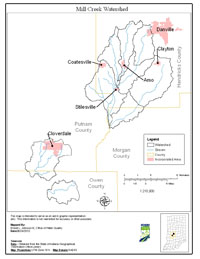Location
The Upper Mill Creek Watershed is located in southwestern Indiana, draining approximately 142 square miles in Putnam, Morgan and Owen counties. Major streams included in the Total Maximum Daily Load (TMDL) report are Upper Mill Creek, Crittenden Creek, East Fork Mill Creek, Sallust Branch, Mud Creek, Mill Creek upstream of Cagles Mill Lake and Ferguson Branch.
History
A comprehensive survey of the Upper Mill Creek Watershed was conducted by Indiana Department of Environmental Management (IDEM) from June 2001 to August 2001. The primary cause of impairment is Escherichia coli bacteria (E. coli). Pollution sources in the watershed include nonpoint sources from agriculture and pastures, land application of manure and urban and rural run-off, as well as point sources from straight pipe discharges, home sewage treatment system disposal and combined sewer overflow outlets.
Pollutants Addressed
TMDLs for the Upper Mill Creek Watershed are established for E. coli and will address 11 impairments. Some of the recommended solutions to address the impairments include storm water controls, point source controls, manure management and habitat improvements.
Timeline
A kickoff TMDL meeting was held on July 27, 2004 at the Danville Public Library, 100 S. Indiana Street, Danville, Indiana starting at 2:00 p.m.
A draft TMDL meeting was held on November 30, 2004 at the Danville Public Library, 100 S. Indiana Street, Danville, Indiana starting at 4:00 p.m. (EST).
The 30-day public comment period for the draft Upper Mill Creek Watershed TMDL began on November 23, 2004 and ended on December 23, 2004.
U.S. EPA under Section 303(d) of the Clean Water Act approved the Upper Mill Creek Watershed TMDL report on March 31, 2005 for 11 impairments. TMDL reports identify and evaluate water quality problems in impaired water bodies and propose solutions to bring those waters into attainment with water quality standards.

